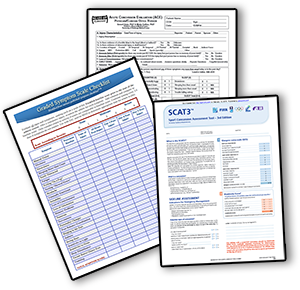Diagnosis
 Courtesy ThinkStock: jeebbus
|
For collegiate athletes, the National Collegiate Athletic Association (NCAA) prefers initial diagnosis as soon after the event as possible, with clinical assessment within 48 to 72 hours. The challenging reality is that in many cases, the young person will show up more than 72 hours after the event, not feeling well but not aware of having suffered a concussion.
|
Right now, there are well-researched assessment tools that are science-based. Other tools are a result of consensus of best practice. It falls to the licensed health care professional to look at the reliability and validity of potential assessment tools, and from that determine which to use and when to use them.
|
|
It’s essential for the licensed health care professional to pull together the data from multiple sources to properly assess the patient, because there is no one perfect assessment tool: there is no "pregnancy test" for concussion that provides a yes-or-no answer.
|
 |
Diagnosis is the first stage of assessment. The patient has to meet the criteria for the definition of a concussion in order for a licensed health care professional to make a clinical decision based on the presentation of symptoms after a known or presumed mechanism of injury. (See Module 2 of this course to review the criteria for concussion.)
|
DIAGNOSTIC ASSESSMENT QUESTIONS |
|
- Child-SCAT5™, for children ages 5 to 12.
- SCAT5™ for ages 13 and up.
References for port Concussion Assessment Tool– 5 (SCAT)
Echemendia RJ, Meeuwisse W, McCrory P, Davis GA, Putukian M, Leddy J, Makdissi M, Sullivan SJ, Broglio SP, Raftery M, Schneider K, Kissick J, McCrea M, Dvorak J, Sills AK, Aubry M, Engebretsen L, Loosemore M, Fuller G, Kutcher J, Ellenbogen R, Guskiewicz K, Patricios J, Herring S. Br J Sports Med. 2017 Apr 26. pii: bjsports-2017-097506. doi: 10.1136/bjsports-2017-097506. [Epub ahead of print]
The Child Sport Concussion Assessment Tool (Child SCAT5).
Davis GA, Purcell L, Schneider KJ, Yeates KO, Gioia GA, Anderson V, Ellenbogen RG, Echemendia RJ, Makdissi M, Sills A, Iverson GL, Dvorak J, McCrory P, Meeuwisse W, Patricios J, Giza CC, Kutcher JS. Br J Sports Med. 2017 Apr 26. pii: bjsports-2017-097492. doi: 10.1136/bjsports-2017-097492. [Epub ahead of print]


